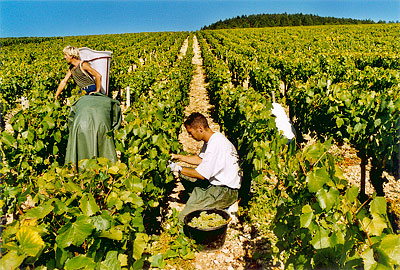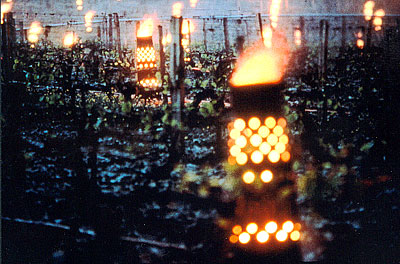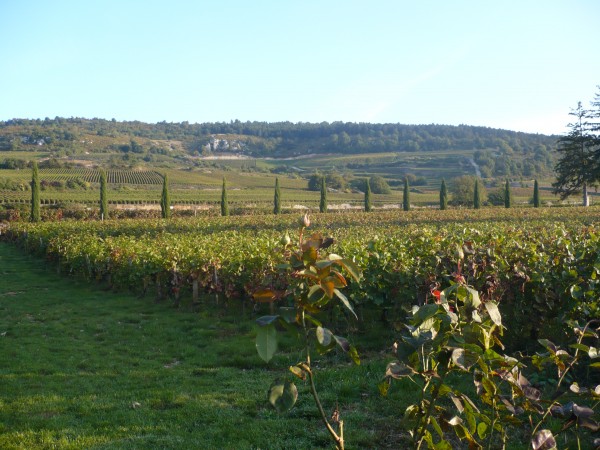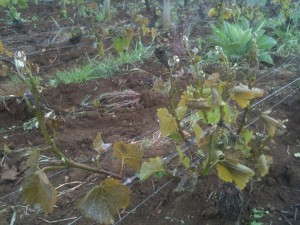General Overview

As everywhere in France, 2012 was not the easiest growing season in Burgundy with the weather causing general havoc. Burgundy suffered a few spring frosts just before flower set resulting in irregular flowering, hailstorms in late spring and early summer and atrocious wet weather for the most of the early summer creating perfect conditions for mildew and oidium. As a result a lot of the potential crop was lost by the beginning of August. However the dry and hot end of summer and picking season saved the vintage – at least in terms of quality. No official figures on the actual size of the vintage have been released (they normally come out towards the end of January) but general predictions are that the overall loss will be 20 to 30% with some regions suffering more than others.
At the presentation of the 2012 vintage at the Sunday morning press conference of the Ventes des Hospices de Beaune, the general predictions were that prices will increases in the near future; reasons are the small 2012 vintage and the small amount of stock currently held at the wineries – an average of only 11 months – as well as a relative healthy demand for Burgundian wine, especially as new markets emerge. However, BIVB officials are warning growers and negotiants to stay reasonable in their price increases and to be loyal to existing markets – they do not want to undress Paul to dress Peter and follow down the slippery slope as Bordeaux has done.

Before I go into actual details it may be useful to point out here that Burgundy is only a small wine growing region in France; with just under 28,000 Ha of vineyards its responsible for only 2% of the total French wine production. It is also a complicated region – there are four levels of appellation: regional, village, premier and Grand Cru level as well as a generic Burgundian appellation (Bourgogne Rouge/Blanc). The generic and regional level wines are considered “entry level” wines and make up most of the volume of the wines produced. It is this category that BIVB officials were especially worried about – as these wines are most sensitive to price increases and volume changes.
In order to see how this vintage could impact a larger Burgundian producer or negotiant, I spoke to Manuela Mouroux, a marketing manager at Louis Jadot. Jadot lost about 30% in quantity this year, with the biggest losses occurring in the Côte de Beaune, where they lost 50% (on average for red and white); Beaujolais is also 50% down. In the Côte de Nuits they are about 20-30% below average and in Fuissé they lost about 30%. The generic and regional appellations are the worst hit, and the company is looking at options to minimize price increases in these categories and recover their losses in other areas.
Chablis and Maconnais
For this vintage in Burgundy, one can see significant regional differences in the losses, with Chablis and Maconnais fairing the best. In Chablis the overall loss is thought to be around 5-10%, however, most of this loss was suffered on the right bank of the river (in Premier and Grand Cru areas). Christian Moreau (Domaine Christian Moreau) harvested about 20% less than normal, but thanks to the VCI (volume complémentaire individuel) the actual volume loss as wine available for release in the next 12 months will be around 15%. VCI allows growers to build up a stock in better years which they can release in times of need under the original vintage. Here, the loss is generally due to the poor flowering and the resulting coulure. The upside, as often happens with coulure, is that the flavor intensity was perfect and Christian is extremely happy with the quality and health of the fruit he harvested. Christian expects a small price increase, but knows he will have to absorb some of the losses as the market will not accept a 15% increase.

Jean-Pierre Aubinel of Domaine de la Pierre des Dames (who is also president of the Macon wine growers) confirmed that damages in Maconnais were rather limited compared to the rest of Burgundy. The average is estimated around 10%. But as Macon is often drunk young, and older stocks at the wineries are very limited, he fears that the shortage will be felt in the market by spring of next year. That is why he is very keen to get the system of VCI implemented in Macon to guaranty stock levels in the future. Whilst he thinks prices will increase slightly, he agrees with Christian Moreau that they will have to be limited if the region does not want to lose significant market share to other Chardonnay producing regions. On a positive note, he feels Macon may benefit from generic price hikes elsewhere as customers may trade down when other Burgundy wines exceed their budget.
Côte de Beaune
The Côte de Beaune was one of the worst hit areas and the official estimate of loss is between 30 and 50% at the moment, but it is generally accepted that the losses in Pomard are up to 70%.


Antoine Olivier of Domaine Olivier, based in Santenay, lost around 50% in total. The main causes for here were poor flowering conditions due to late spring frosts and the hail storms in June and July. Antoine lost so much fruit that for the first time in 20 years he will not be making regional red or white wines. At Domaine Olivier they worked very hard in the vineyard (which is certified organic) to protect the few grapes they had and in the end Antoine was happy with the quality; the reds are bright and deep in color with a great acidity, tannin structure and fruit intensity and whites are showing a wonderful acidity and ripe fruit flavors. The size of this vintage directly impacts the domaine as the loss is so significant. This is why Antoine has been working with an accountant to see how they can best salvage the situation. He predicts his wine will be on allocation for the 2012 vintage and maybe even a little before its release, and he expects the prices will increase up to 20% between the 2010 and 2012 vintages. He sees difficulties continuing well into 2014 as he will have to try and keep his customers happy with significantly less wine.
Roland Mass, the manager of the Domaine des Hospice de Beaune declared similar figures for the Côte de Beaune; he also did not make a Beaune village wine this year because of the grape shortage. Nevertheless, Mass was over the moon with the quality of the grapes and wines, and he believes 2012 will go down in history as one of the great vintages of Burgundy. The potential of an iconic vintage together with its limited availability resulted in a 50 % price increase compared to last year at the legendary “Ventes des Hospices de Beaune” auction which traditionally has set the tone for the Burgundy category, according to BIVB president Pierre-Henri Gagey.
Côte de Nuits
Official estimates for the Côte de Nuits were about 20% down. These were echoed by Roland Mass, however Raphael Dubois of Domaine Dubois explained that damages fluctuated quite a bit by sub-region. In the North, up to the village of Marsannay, hail wiped out 30 to 40% of the crops. The middle part, from Fixin to Nuits St Georges, did relatively well with losses being limited to 15-20%, and South of Nuits St Georges, hail storms once again were responsible for a loss of around 30 to 40%. Raphael is down about 40% on the average; last year he was 15% under and in 2010 30%, this makes 2012 the 3rd year in a row that volumes are below average and he sees no other options than to impose further price increases. Raphael doesn’t think that this will be a big problem for the Premier and Grands Cru wines as these are well sought after and produced in very small quantities. However, things get more difficult for the regional wines as he will need to absorb more of the loss himself and allocate the little wine he has carefully in order to protect all the markets he has at the moment. He believes the next few years will be challenging as he will have to balance availability and price in with the demands of his main markets.
Beaujolais
The damages in Beaujolais were a hot topic at the Hospices de Beaune in November as the region is one of the worst hit areas in Burgundy. It destroyed hopes of the Burgundians to further develop the Coteaux Bourguignons – the new appellation category of red wine to capture the entry level market (5-7 euros). Volumes in Beaujolais remain precariously low as winemakers favored the Beaujolais Nouveau market to help their cash flow. Anne-Victoire Monrozier of Miss Vicky Wine confirmed the official 50% loss for her Fleurie; the main culprits were frost during flowering and the resulting coulure which created a lot of extra sorting work at harvest to exclude dried or unripe berries from the bunches. The wines are looking promising though, with a great tannin and acid structure and a good fruit intensity. Anne-Victoire believes prices will certainly rise because of this year’s smaller volume and an increase in popularity of Beaujolais the last few years. She believes this may not be a bad thing as it will allow the region to establish more sustainable pricing especially in newer markets.
Conclusion

2012 was an interesting and often difficult year in Burgundy; the quantity of grapes harvested is at least 20% below average, but in some regions the losses have been as high as 70%. Furthermore low stocks currently held at the domains will make it difficult for wineries to maintain their market shares. The overall quality of the wines is excellent which may add to an increased demand especially from emerging markets, and fuel expectations of price hikes. However, the Burgundy Wine Board (BIVB) is urging producers and négotiants to keep the increases to a minimum and to allocate wine in such a way to maintain their current market share.
[author] [author_image timthumb=’on’]http://palatepress.com/wp-content/uploads/2012/05/caro_twitter-e1337129825708.jpg[/author_image] [author_info]Caroline Henry is a wine educator as well as a wine marketing and social media consultant based in Champagne. She holds a WSET advanced certificate and is a certified sommelier studying for her advanced sommelier certificate. She has a particular interest in Champagne, terroir and natural wines and food and wine pairing. She blogs about all things wine related at Missinwine and Vinogusto[/author_info] [/author]
